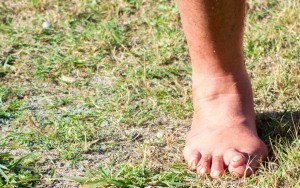Learn more about the condition “Overriding and Underriding Toe”
An overriding toe condition occurs when one of your toes, usually the big toe or pinky toe, extends over the adjacent toe. A similar condition, called an underriding toe, develops when your toe extends under the adjacent toe. The toe is then dorsiflexed and adducted, overriding the adjacent toe, with external rotation, causing the toenail to face laterally. This condition is often seen in young children. It can be seen in adults due to another underlying condition, such as rheumatoid arthritis, or bunion joints.
Symptoms of Overriding Toe
- Pain from irritation of the overlapping toe on the top of footwear.
- Callused areas on the tops of the affected toes.
- Often involves the 5th or 2nd toes, but may occur with any of the lesser toes.
Causes of Overriding Toes
The exact cause of overlapping toes is still unclear, but a number of factors are considered responsible for overlapping toes.
- Genetics, as the condition runs in families.
- Position of the fetus during development inside the womb may affect the position of toes
- High arches or flat feet (fallen arches) in children alter the normal biomechanics of the foot, leading to overlapped toes, mostly the fifth toe.
- Hammer toes (toes bent in the form of a hammer) can also lead to overlapping of toes.
- Bunions cause the big toe to bend outwards towards the smaller toes, cramping their space and causing them to overlap. Usually the second toe overlaps.
- Ill-fitting shoes: high heels with narrow toe sections cause cramping of the toes. Prolonged cramping may also lead to overlapping of the toes.
- Long second toe
- Injuries, as dislocated joints may also be a reason for the overlapping of the toes.
Treatment of Overriding Toes
- Orthotics: Treating poor biomechanics with the use of an Orthotic will assist in realigning the foot, and improve foot function.
- Footwear:A well fitting shoe that provides adequate support and shock absorption. Footwear must have adequate width and depth around the toes to prevent any irritation.
- Padding: Your practitioner may apply padding to your toes to reduce the overlapping.
- Toe separators: With the advice of your practitioner, a small device may also be placed between the affected toes to reduce the overlapping.
- Surgery: One extreme treatment option also if all options above are not effective
Are you suffering from this condition? One of our podiatrist can assist and recommend what treatment options are best to get you back on track. ✅
Schedule an appointment here or you may call us at 44 (0) 207 101 4000. 📞
We hope you have a feetastic day! 👣☀️
-The Chelsea Clinic and Team
Check our latest blog about Ankle Sprain here https://www.thechelseaclinic.uk/ankle-sprain/
Check our blog about Tiptoe Walking Children here https://www.thechelseaclinic.uk/tiptoe-walking-children/
Read our blog about Plantar Plate Injury here https://www.thechelseaclinic.uk/plantar-plate-injury-%f0%9f%91%a3%f0%9f%a6%b6%f0%9f%92%a5/




